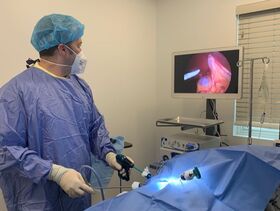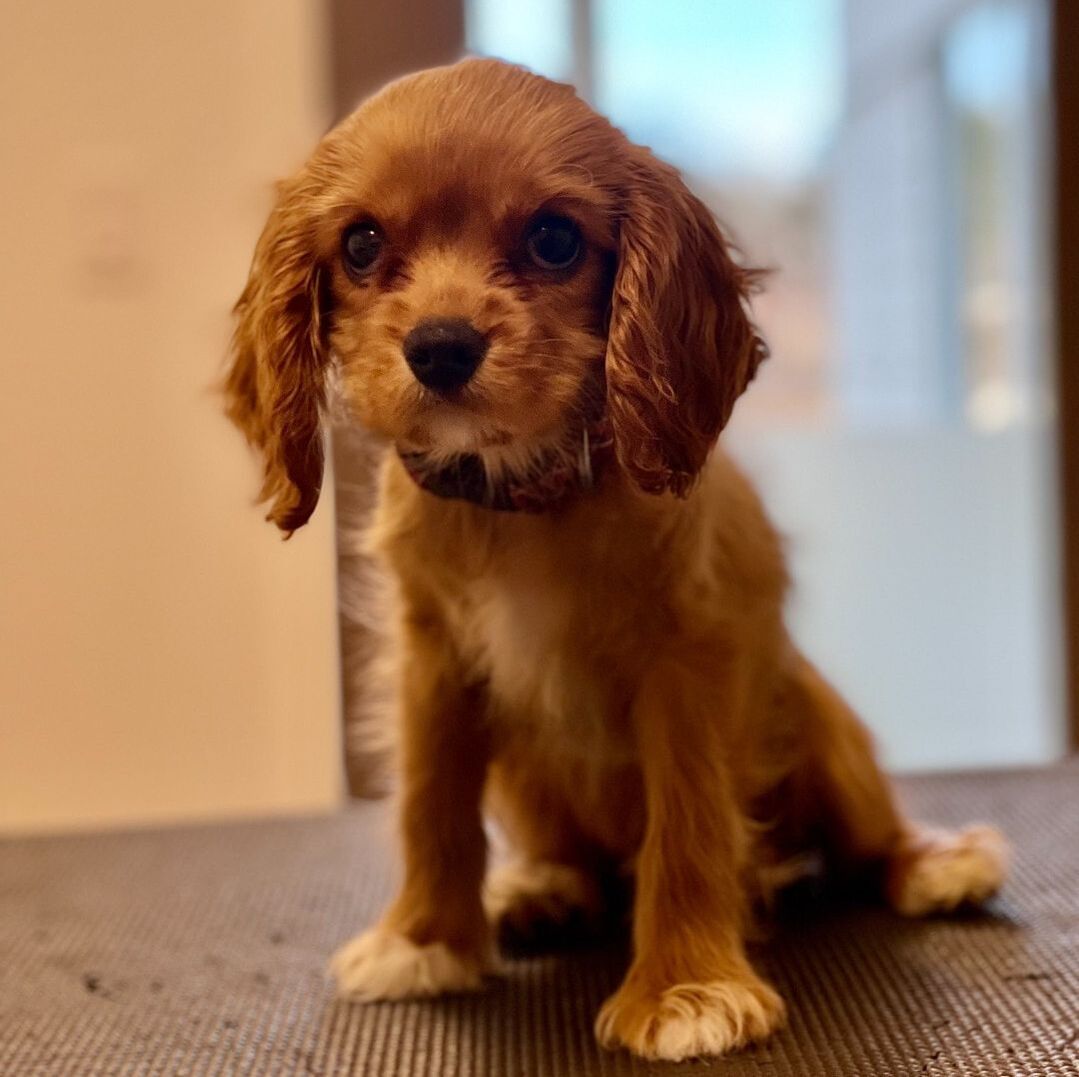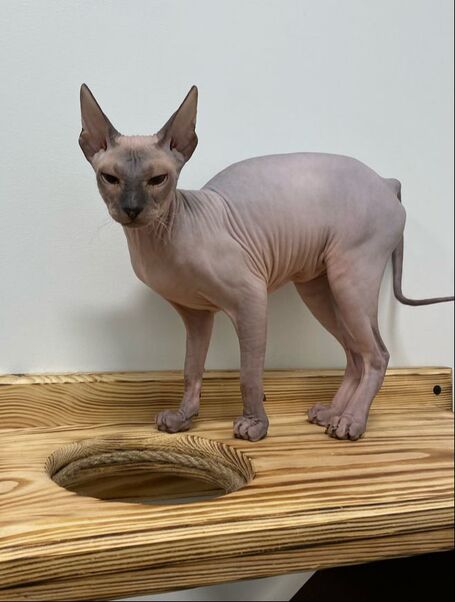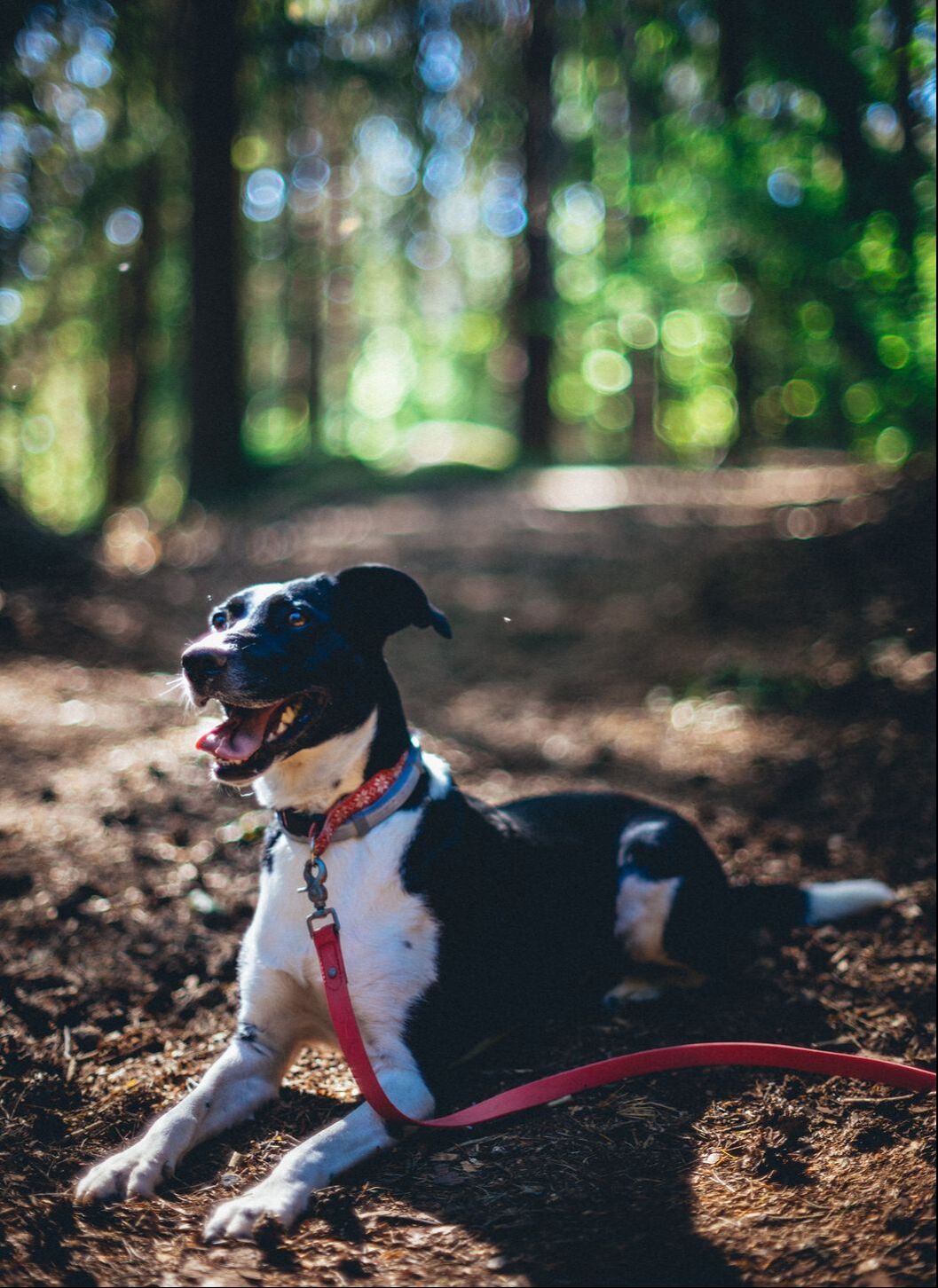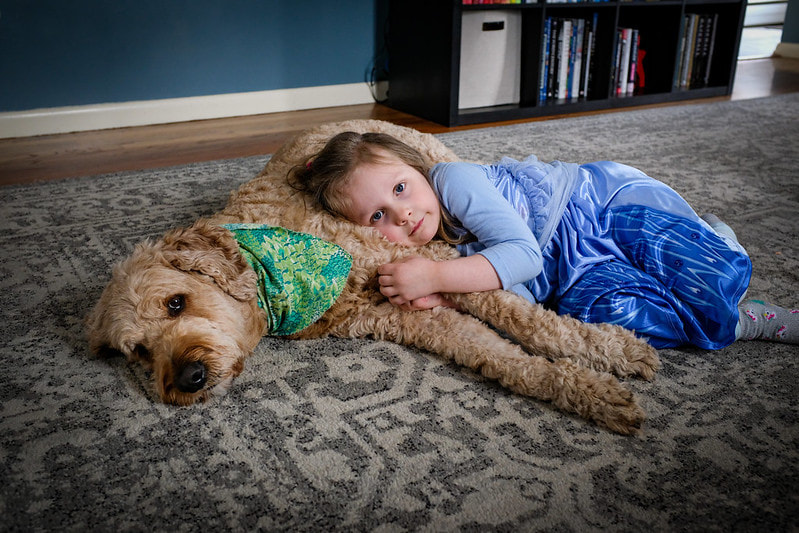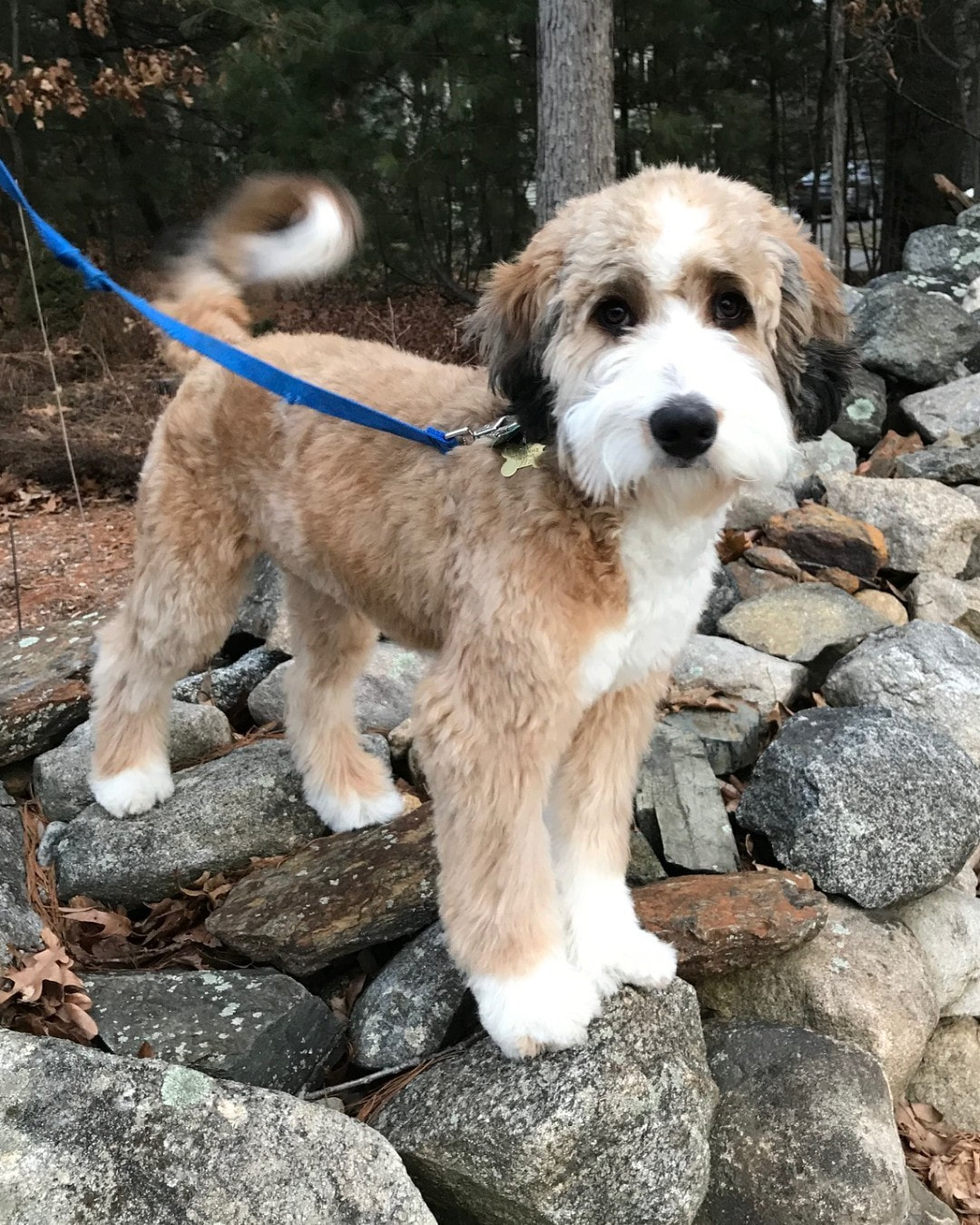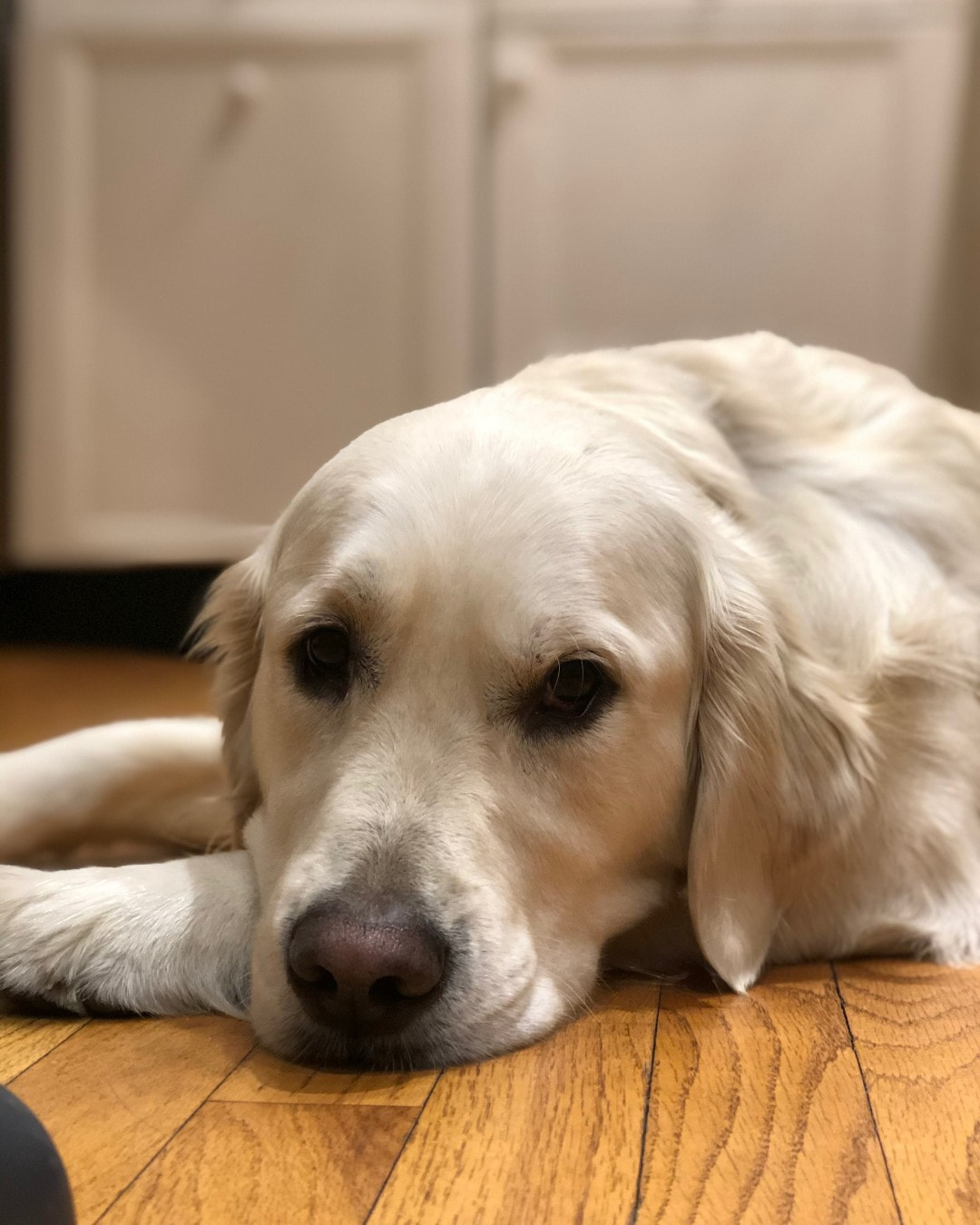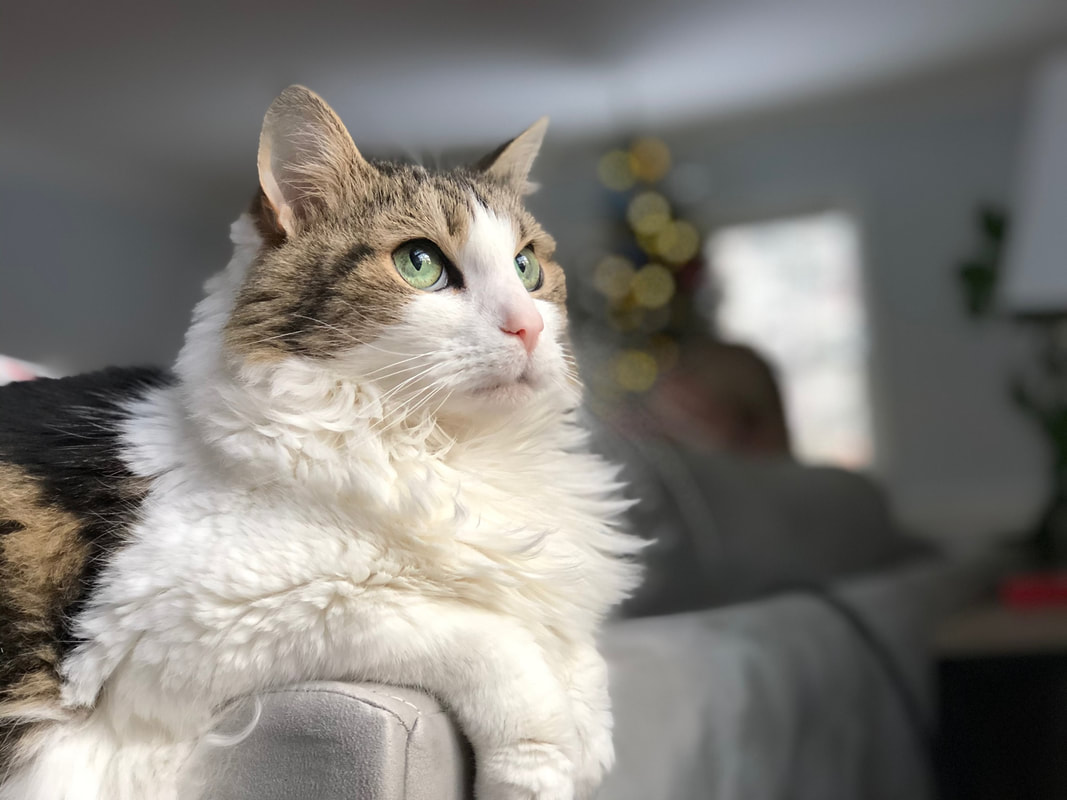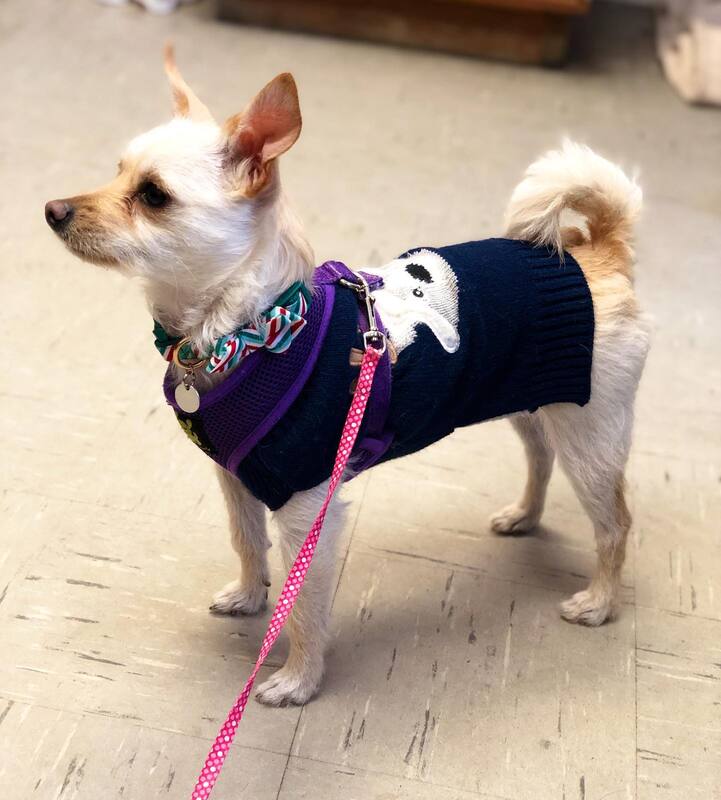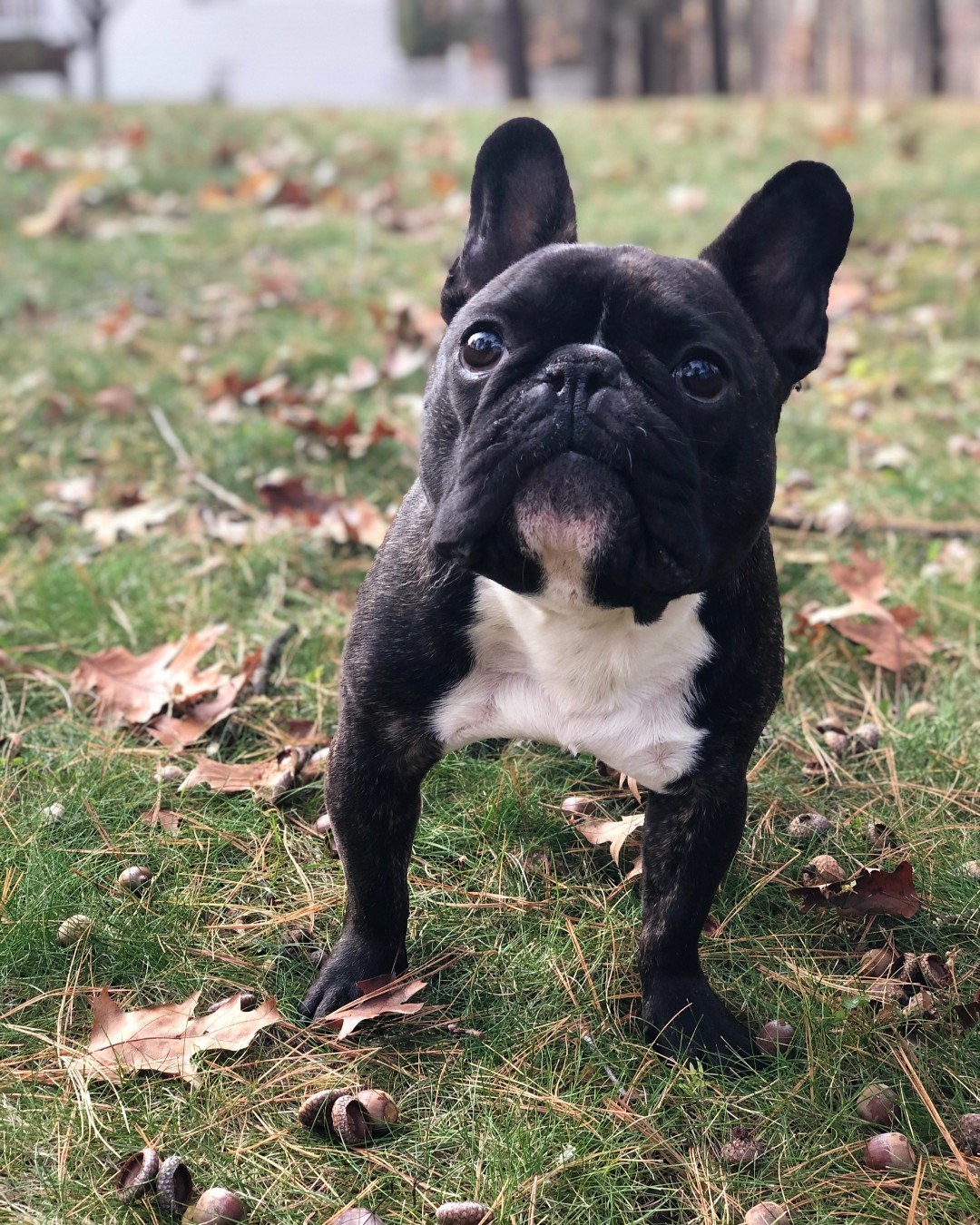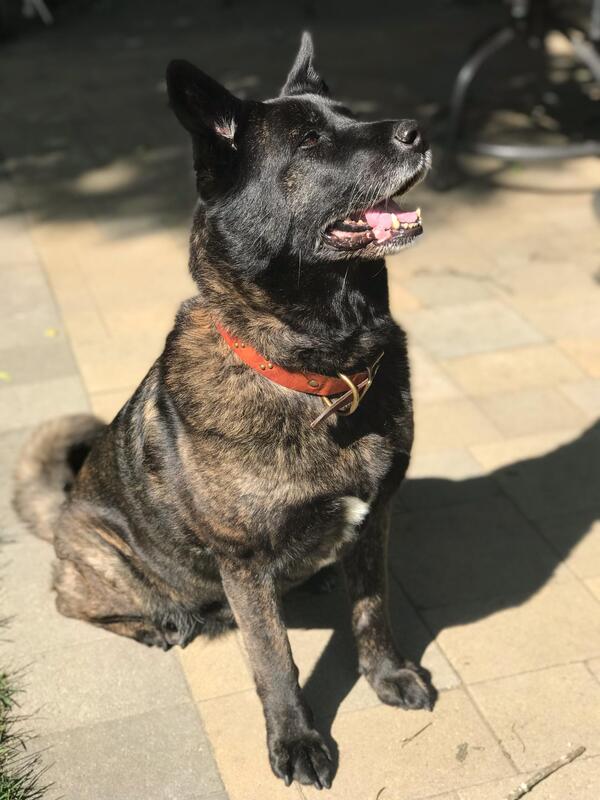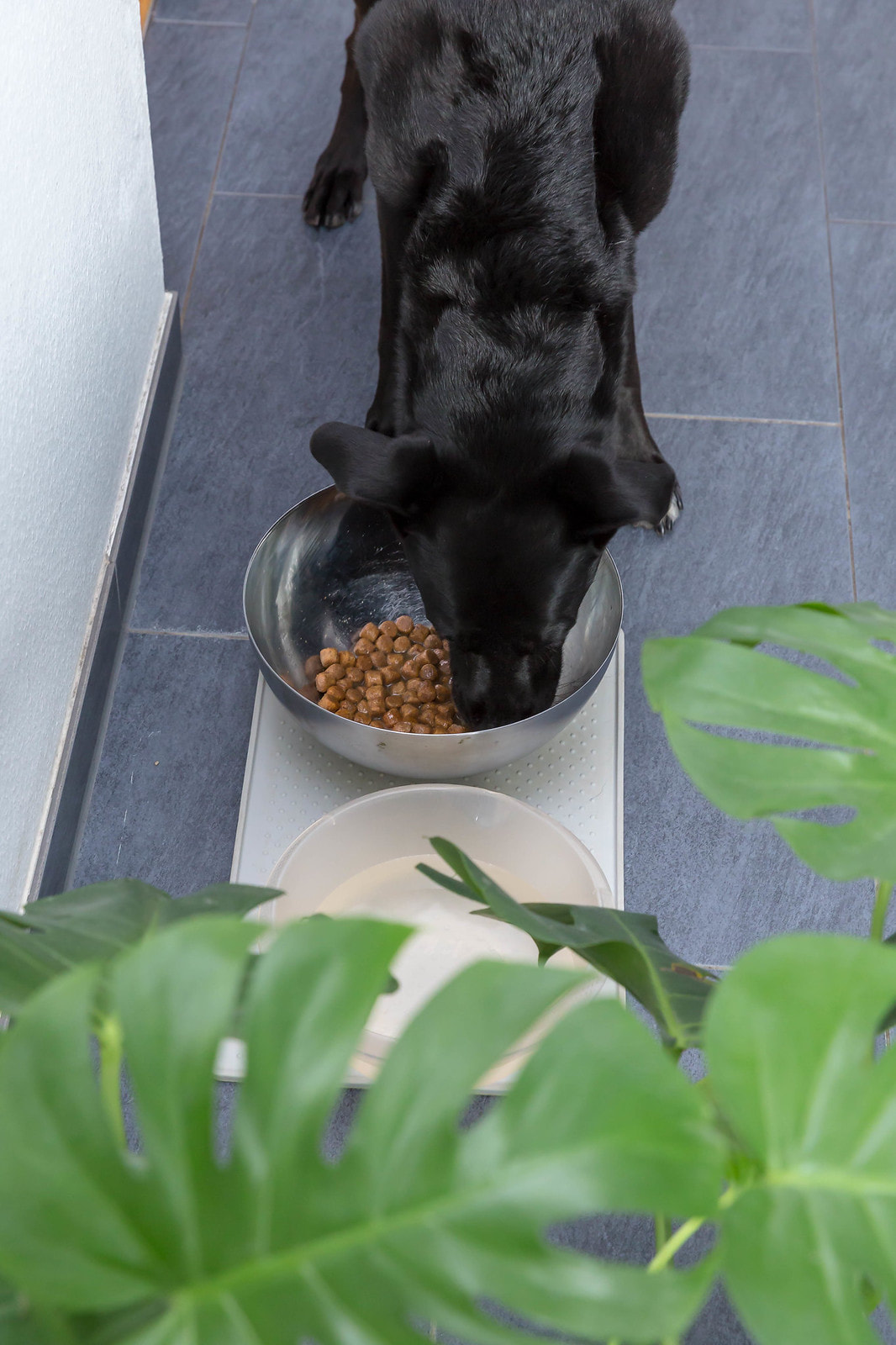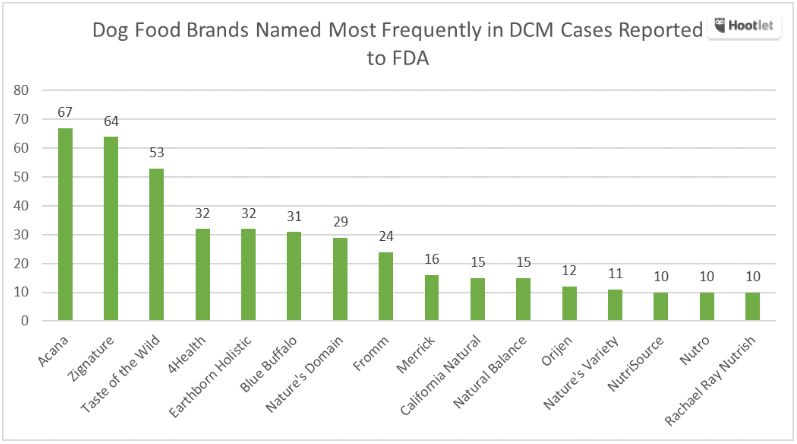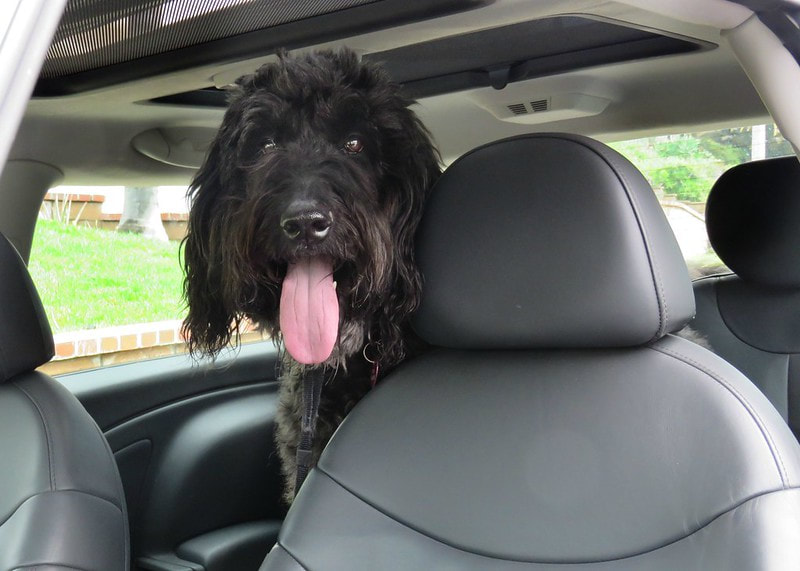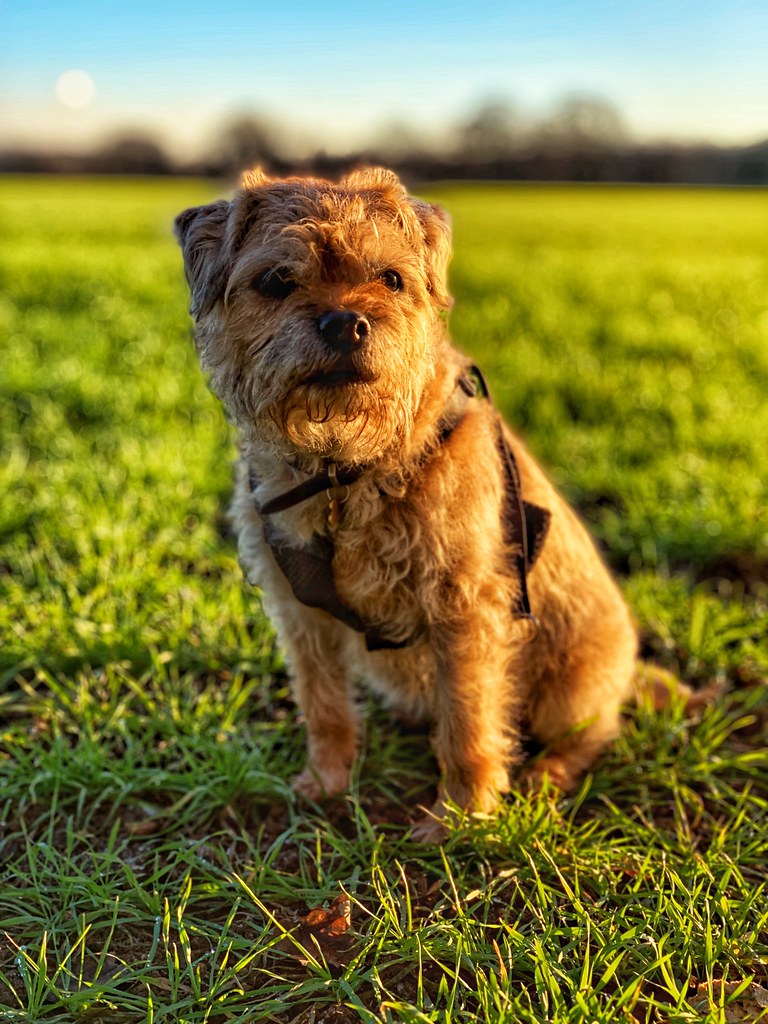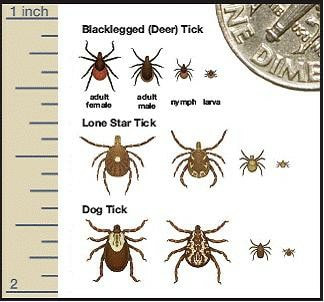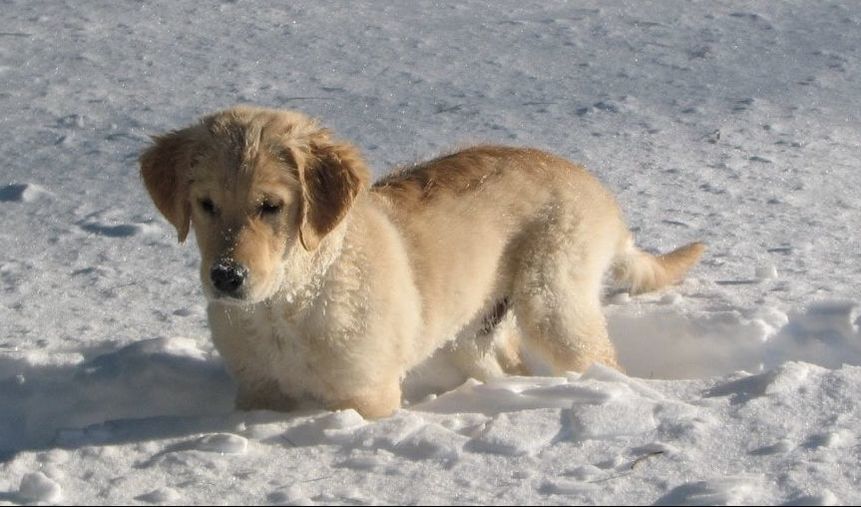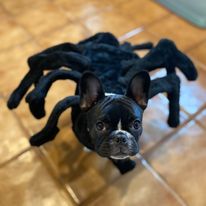 Petal Wilson ready to terrorize the neighborhood Petal Wilson ready to terrorize the neighborhood Do you feel that? The nights are growing longer, the air is growing colder, and there’s something sinister lurking around every corner. While we all know Halloween candy can pose a threat to our pets and trick-or-treaters can give them a fright, this year we’re talking about a lesser-known danger that’s just as sinister. It’s a danger that lurks in plain sight, a danger that few of us ever think about, a danger that’s coming from inside the house. This year we’re talking about… Decorations. We all enjoy turning our homes into dens of dastardly horror this time of year, but we rarely think of the plastic skeleton in the corner as an actual threat. Our fuzzy friends, on the other hand, might not recognize the difference between play danger and real danger- and as it turns out, that difference might be smaller than you think! This month we’re talking about Halloween decorations, and sharing our top tips to haunt your house without having to haunt the vet’s office. So steel your nerves, find a safe place to hunker down, and read on… If you dare.  Pupmkin's without candles are Jules-approved decorations Pupmkin's without candles are Jules-approved decorations
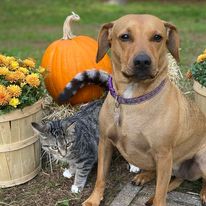 Harper & Kitten pose for a purr-fectly safe fall picture Harper & Kitten pose for a purr-fectly safe fall picture If this were a horror movie you’d have to face these dangers alone, or perhaps with a group of ill-fated friends, but fortunately it’s (probably) not. We want you all to have a Halloween that’s fun and spooky while still remaining safe, and we’re here to answer any questions you might have. If you’ve got concerns, whether they’re about decorations or general Halloween safety, feel free to get in touch! Less than half of our staff have been possessed by malevolent spirits, so our advice is usually trustworthy.
Vaccinated, Unvaccinated, or Not Currently Vaccinated? Before we get into all the different rules and regulations, we need to define some terms. Vaccinated and unvaccinated are pretty self-explanatory, but you might be scratching your head over the difference between unvaccinated and not currently vaccinated (I even got them backwards while I was writing this paragraph). Fortunately it’s actually pretty simple: an animal who currently has an up-to-date rabies vaccine is considered vaccinated. An animal who has previously received a now out-of-date rabies vaccination is considered not currently vaccinated (remember that at CAH your dog’s first rabies vaccination will last for one year, and all future boosters will last for three years - we only administer one-year vaccinations for cats). An animal who has never received a rabies vaccination, or received their first vaccination less than 28 days before the bite occurred, is considered unvaccinated. Easy, right? Pet not up to date on their vaccines? Let's fix that asap! Call to book a vaccine appointment today. Scraps at the Dog Park We’ll start with what to do if a domestic animal bites another domestic animal. Maybe your pup got a little too close to an unfriendly stranger at the dog park, or maybe playtime with a housemate got a little too rough. If your pet bites or is bitten by a domestic animal belonging to another person, get their information, and give them yours. If your pet is bitten by another domestic animal who is identifiable, the biting animal is quarantined within the owner’s home for 10 days. If the other animal is not identifiable, your poor pet ends up in quarantine for 45 days! They don’t want that, and we’re sure you don’t either. If your animal happens to be the biter they’ll have to go into a 10 day quarantine. This means they should be kept inside your home, should not have any contact with other people or animals, and should only be taken out on-leash to use the bathroom. The word quarantine sounds scary (and might bring back some unpleasant memories of early 2020), but fear not! While dog bites and quarantines do need to be reported to the town, you aren’t in any trouble and no punitive measures are taken. You won’t be fined, your dog won’t be taken away, and you have nothing else to worry about. The only purpose of these quarantines is to prevent the possible spread of rabies while your dog is monitored for symptoms. 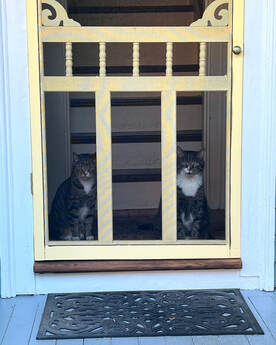 Tussles in the Woods If your pet gets bitten or scratched by a wild animal while out for a walk, or ends up with a wound of unknown origin, the rules are a bit different (and unfortunately a bit stricter). If your pet is vaccinated or not currently vaccinated and they get scraped up in the woods, you should bring them in as soon as possible to have their rabies vaccine boostered - this is the case even if your pet is currently up-to-date. After this your pet will need to go into a 45 day quarantine to monitor for rabies symptoms. If your pet is happy and healthy at the end of this period, no further action is taken. If your pet is bitten or scratched by a wild animal or receives a wound of unknown origin and they’re unvaccinated they should also be vaccinated as soon as possible, after which they’ll have to go into a four month quarantine. If your unvaccinated pet had contact with a wild animal that is confirmed to have been rabid by a state laboratory, they’ll need to spend the first 3 months of this period in full isolation at an approved animal hospital, kennel, or livestock quarantine facility. Fortunately this is easily avoided by vaccinating your pet before it becomes necessary!
In Summary… So there you have it! Hopefully this post has answered your questions, and has helped to make the prospect of an animal bite a little less scary. We were mostly focused on the protocols and the paperwork, but that does leave off one of the most important pieces of advice: if your pet ends up with a bite or a scratch from any source, you should always have them checked out. We can clean up the wound, make sure it’s healing properly, help prevent infection, and even give your pet some pain meds if they need them. As always, we try to cover what we can in these blogs, but we’re sure we didn’t get to everything! If you’ve got any other questions we’re always happy to chat, and if you do ever find yourself dealing with animal bite just give us a call and we’ll be glad to help you through it- but fingers crossed you won’t have to make that call any time soon! 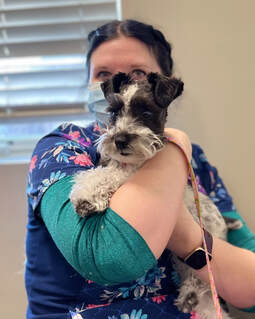 CAH Technician Mary enjoying a snuggle CAH Technician Mary enjoying a snuggle It’s no secret that our pets make us happy. We all love being bombarded with animal attention as soon as we walk through the front door, and even a cute pet photo can be enough to brighten our mood on a crummy day. But the connections we feel to our furry friends run even deeper than that! May is Mental Health Awareness Month, and it’s a well-documented fact that pets have a lot to say in this conversation. So today we’re talking about our pets, our mental health, and the amazing links that exist between them.  Luna's silly face has to brighten your day Luna's silly face has to brighten your day Pet ownership encourages all sorts of wonderful improvement to our behaviors and our routines, but we’ll start even more basic than that: hormones! Hormones are chemicals that act as our body’s messengers. They can have a huge impact on our physical and mental health, and our pets can have a huge impact on our hormones! Spending time around our pets can trigger releases of the feel-good hormone dopamine, and simple eye contact with our dogs can be enough to release the “cuddle hormone,” oxytocin. And on the flip side, spending time with pets can lower levels of cortisol, a hormone that contributes to stress and anxiety. So when cuddling up with your dog makes you feel better after a long day at the office, it’s not just in your head- it’s in your endocrine system as well! We also owe a lot to endorphins, a group of hormones that are basically your body’s natural opioids (without the nasty side effects). One reliable way to trigger a rush of endorphins is through exercise, and just a few minutes of activity a day can bring about improvements in your physical and mental health. Even if you don’t have the time or the energy to hit the gym, a ten minute walk with your canine companion can still be enough to get those endorphins flowing!  Taking Vanushka for a walk is good for Vanushka and her mom! Taking Vanushka for a walk is good for Vanushka and her mom! Taking your dog out for a walk can also be a great chance for socialization, for you and your pup alike! While we all know socialization is important for our dogs, it’s just as important for us humans. Face-to-face socialization with others has been shown to help alleviate symptoms of depression, especially in individuals over 50 (mental health matters at every age!). So while you might think your trips to the dog park are just for your pup’s benefit, think again! Even short conversations with other dog owners can provide a boost to your mental state. Of course, a lot more goes into owning a pet than cuddles and occasional walks in the park. They need to be fed, groomed, exercised and played with regularly, and require lots of attention and affection. While these responsibilities can seem daunting, especially if you’re already struggling to keep up with the other responsibilities in your life, the two can actually go hand in hand. NAMI, the National Alliance on Mental Illness, find that taking care of another creature can improve pet owners’ sense of self-worth and their confidence in their ability to take care of themselves. Pet ownership also tends to come with routines, and building a routine to take care of your pet can help you stick to your own self-care routines as well. Not to mention, maintaining a regular routine is shown to help improve sleep! Who doesn’t love that? Even now, we’re only beginning to understand the links between animals and mental health. New studies are coming out every day exploring these connections further, and the more we discover the more we can find ways to take advantage of these effects. Animal Assisted Therapy is becoming increasingly popular as a supplement to standard therapy regimens, while new studies are focusing on the impact animals might have on the development of children, especially those with certain conditions such as ADHD or autism. So our pets are pretty cool, huh? But while they love us unconditionally and brighten our days just by being there, we know they can’t do everything. If you’re struggling with mental health and need help or guidance, don’t be afraid to reach out! Mental Health America has put together a wonderful guide that can help you figure out where to start, and can make the process of finding help a little less daunting. And if you won’t do it for our sake, then consider doing it for your pets’. We know it’s what they want. 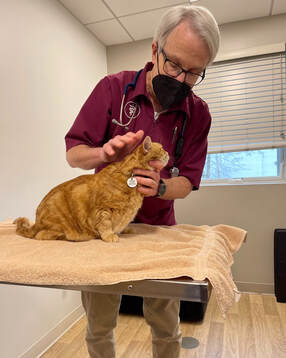 One of our favorite veterinarians, Dr. Hardie, hard at work One of our favorite veterinarians, Dr. Hardie, hard at work On a personal note… As veterinary professionals, Mental Health Awareness Month is a cause close to our hearts. 1 in 6 veterinarians will consider suicide at some point in their career, and the number of veterinarians experiencing extreme psychological distress has increased since the beginning of the pandemic. Not One More Vet is a nonprofit organization that aims to address the growing mental health crisis in the veterinary industry through education, outreach, peer support, and grant programs. Visit their website to learn more, make a charitable donation, or get involved as a volunteer. In our continued efforts to provide the highest standard in medical care for your pets, we are thrilled to announce the addition of laparoscopic surgery to Concord Animal Hospital's services.
 Petal three days after her LOVE Spay Petal three days after her LOVE Spay Laparoscopy has been used in human medicine for the past 25 years and the team at Concord Animal Hospital is excited to help drive its adoption in veterinary medicine. “A laparoscopic procedure offers so many benefits for pets and owners,” says CAH owner and Veterinarian Dr. Wilson. “The incisions are significantly smaller, there is less tissue handling, and less time under anesthesia. All of this results in a faster and safer procedure for pets. The recovery time is days instead of weeks and your pet will be in far less pain.” Dr. Wilson adds, “yes, that does mean just a couple of days in a cone with exercise restriction instead of two weeks. This is a tremendous benefit, especially for puppy owners!” Laparoscopy is not necessary for all surgical procedures. “Laparoscopy is a great alternative for procedures where the team needs to access deeper into the body cavity. These procedures require large incisions and handling of vessels and tissue with a traditional surgery,” notes Dr. Wilson. “A LOVE Spay, short for a laparoscopic ovariectomy, is a great spay alternative for large breed dogs, overweight pets, and for pets who have gone through a heat cycle.” With some exceptions, your veterinarian will recommend a traditional surgery for neuters of male pets instead of a laparoscopic surgery. Let’s face it: “surgery” is a scary word. The idea of bringing your pet in for a surgical procedure is daunting, and even a routine procedure like a spay or a neuter can be stressful if you’ve never been through it before. That’s why we’ve sat down with CAH’s own Dr. Kaitlin Rondeau in order to demystify the process and explain what to expect leading up to, on the day of, and in the days after your pet’s procedure.  Dr. Kaitlin Rondeau helps to demystify your pet's surgical procedure! Dr. Kaitlin Rondeau helps to demystify your pet's surgical procedure! The months before Your pet’s veterinarian will work with you to determine when a surgery might be beneficial to your pet. Spays and neuters are fairly routine and typically happen between 6-12 months. Depending on our vet’s findings during their checkups they may also suggest dental procedures, such as cleanings or extractions, or mass removals to get rid of any odd lumps and bumps. If your pet has never seen us before, we’ll want to book an initial checkup with a doctor prior to scheduling a surgery. From there we’ll also want to perform some tests to make sure your pet is healthy enough to undergo anesthesia. “With any patient we want to perform bloodwork to check liver and kidney function, since these are the organs responsible for metabolizing anesthetic drugs,” says Dr. Rondeau. “If your pet has other medical concerns we may also recommend further testing, such as an ultrasound.” At these preoperative visits we’ll also prescribe dogs a medication called Cerenia, which is an anti-nausea medication used to prevent vomiting under anesthesia. Cats do not require Cerenia. The night before surgery, your pet should have dinner no later than 6 pm, and the Cerenia should be given that evening. Water is okay including on the morning of the procedure, but your pet should not be fed overnight or the morning of the procedure.  The day-of When you arrive the morning of your pet’s surgery, our receptionists or technicians will go over paperwork and ask a number of intake questions. They’ll confirm that your pet was fasted and received any necessary medications, and will also ask about any symptoms of illness your pet may have shown recently. “If your pet has recently experienced symptoms like vomiting, diarrhea, lethargy, disorientation, or loss of appetite, that’s important to know,” Dr. Rondeau says. “Surgery can be taxing on your pet’s body, so we don’t want to move ahead if they’re already feeling under the weather.” While the procedures we perform here are very low-risk, our staff will also ask whether you would like CPR to be administered in the event of an emergency. We’ll always make an effort to contact you before doing anything outside of the scope of what we’ve discussed, but we want to get your permission to perform CPR in advance so we can take action immediately if necessary. Once our staff is finished with intake questions our technicians will bring your pet inside, and you can go home and try to relax! The attending veterinarian will call you after the procedure (usually early afternoon) to let you know how everything went, cover discharge instructions, and give you a pickup time. In the case of some procedures such as dentals, the doctor may also call you to discuss a plan after x-rays or an exam are performed. “Sometimes radiographs and sedated exams will reveal additional pathology that we weren’t able to notice during a normal exam,” Dr. Rondeau explains. “For example, we may discover a need for more dental extractions than we originally realized.” In cases like these, our doctor will give you a call to go over a plan before proceeding with any additional work. When you come to pick up your pet one of our technicians will go over discharge instructions one more time, and will answer any questions you might have before sending you on your way. But we like to keep in touch, so we’ll call you within the next day or two to make sure your pet’s recovering well. 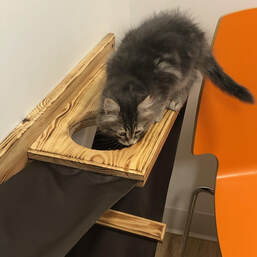 The weeks after Your pet may be a little loopy after coming up from anesthesia, so it’s important to make sure they’re supervised for the next 24 hours. That evening you can offer a small amount of food and water, about half of what your pet usually receives. If your pet had a dental procedure you may see a small amount of blood in their food or water dish - don’t panic, this is normal! Regular eating and drinking can resume the next day. Your pet will also be sent home with medication to help alleviate pain and limit their activity if they tend to be especially energetic. Typically you can start these medications the first evening your pet’s home, but precise instruction will be given at the time of discharge. For our spay, neuter, and mass removal surgery patients, you’ll want to heavily limit exercise for the next five days. “Basically, we want to make sure there’s no risk of your pet reopening their incision site,” Dr. Rondeau explains. “Keep them on a leash during walks, don’t let them go up or down stairs, and keep them away from other pets.” On the sixth day you can gradually start to increase your pet’s activity level, but you still want to take it easy during this time. The full healing process takes 14 days, so avoid long walks, play with other pets, bathing, or swimming until this has passed. Keep checking your pet’s incision site daily for swelling, redness, discharge, or missing sutures. If your pet had a dental procedure, don’t offer them any hard treats or chew toys during this time, but you won’t need to restrict their activity after the first day post-procedure. If you observe any facial swelling, bad odor, drooling, or mouth sensitivity let us know. If you think something you see doesn’t look right, give us a call at 978-369-3503, or send a photo to [email protected].
 Not that bad, actually. But we’re getting there and we're here to help you prep your pet! The air’s turning cold, the days are growing shorter, and winter is on the horizon. But as much as we all love sledding, snowball fights, and warm mugs of hot chocolate, winter also brings with it some unique petcare challenges that aren’t present during the warmer months. Keep your winter more delightful than frightful by following these quick tips for winter weather safety! Frosty Fleas (and Ticks, and Heartworm): If there’s one upside to winter temperatures it’s that all those nasty warm-weather parasites have died off, right? Wrong! Ticks can be active in temperatures as low as 40 degrees, while fleas can get all the way down to 33 degrees. And while New England winters are colder than this on average, it’s not uncommon to end up with a few unseasonably warm days in the middle of the coldest months. If you’re thinking “Wow, what beautiful weather!”, then unfortunately so are those pesky parasites. That’s why we strongly recommend continuing flea, tick, and heartworm prevention year-round, no matter how cold it is. Wipe those paws: The same salts that prevent us from slipping on icy sidewalks and injuring (or embarrassing) ourselves can be rough on a dog’s paws. Wiping your dog’s paws down after a walk can prevent irritation to their paw pads, and will also keep them from licking off residue that can be harmful or toxic. Depending on how sensitive your dog’s paws tend to be, you can also consider using booties or paw balm to help protect them during your winter outings. There’s one piece of advice we always give (and this one’s good year-round): to give us a call whenever you’re unsure! If you’ve got winter-weather questions, think somethings not right with your pet, or want to schedule a visit or stock up on essentials, give us a call!  Mind your mercury: You know, like they used to put in thermometers? Just like humans, dogs and cats can be sensitive to the cold, and can suffer from frostbite or hypothermia. Limit their outdoor time once temperatures hit freezing, and consider putting a sweater on puppies or dogs with short coats. Don’t leave them alone in your car either; a freezing car can be just as dangerous as a hot one! Get ready to get snowed in: There’s a big difference between “Snow day” and “Snow week.” Hope for the best but plan for the worst by making an emergency kit ahead of time, so you’ll be prepared in the case of an extended power outage or a prolonged snow-in. We recommend keeping at least three days of your pets’ food, water, and medication, as well as some special toys and treats to help keep them relaxed while they’re cooped up. And be sure to check out mass.gov’s Winter Storm Safety Tips for general advice about keeping your home and human family members safe as well! 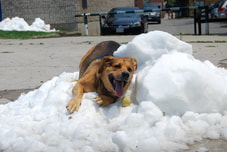 Check your car: The inside of your car’s hood might not sound like a cozy resting place to you, but to your cat a warm, enclosed space like that is prime napping real-estate. Before starting your car make sure any cats in your house are accounted for, and check your hood or make some noise to flush out any feline stowaways. Chip ice and chip pets: If you’ve sniffed one snowflake, you’ve sniffed them all. A thick blanket of freshly-fallen snow looks beautiful to us, but it can also cover up familiar scents and make it harder for a wandering pet to find their way back home. Prevent your dogs from getting lost by keeping them on a leash during winter walks, and increase your odds of reuniting with a lost dog or cat by microchipping them and giving them a well-fitting collar with up to date contact information. For some additional winter petcare advice, check out our previous blog on the same topic. Now bundle up, light a fire, and let’s make this winter a great one! 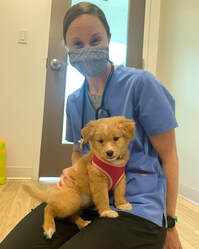 Hurricane season in New England lasts from June to the end of November, but emergencies also come in less predictable forms throughout the year, such as house fires and tornadoes. When disaster strikes, your pets are almost completely dependent on you to survive. Follow Concord Animal Hospital's 5-point emergency checklist to keep your pets safe during an emergency. 
If you’re about to adopt a new cat or are thinking about adding one to your family, let us be the first to say congratulations! And if you’ve recently adopted a new kitten and have a hundred different questions about what to do now, we’re here to help! Whether you’re a first-time cat owner looking for guidance, or a cat connoisseur looking to brush up on your pet-ownership expertise, here’s a handy list of questions, answers, and information you might find useful.
What is a Vaccine? A vaccine exposes the immune system to inactive or incomplete disease-causing agents to train it to quickly and effectively respond if it ever encounters the real deal. Typically we recommend vaccinating new kittens with the pankluemia, rhinotracheitis, and calvivirus (PRC) vaccine and the rabies vaccine. We may also recommend the feline leukemia vaccine for outdoor cats. Vaccines are safe and effective. Reactions are rare and not typically life threatening when treated properly. For more information on vaccine reactions, what to watch out for, and how to treat them, check out our April blog post. Fleas, Ticks, and Parasites, Oh My! Nobody wants fleas and ticks on their pets or in their homes. Fleas can transmit intestinal parasites, and while tick borne diseases like anaplasmosis are less common in cats than in dogs, they’re still possible. The good news is that flea and tick preventatives are safe, effective, and easy to give. We typically recommend topical preventatives like Revolution for cats, since cats are less likely to take a chewable tablet. We also advise continuing flea and tick preventatives year-round, as even in winter ticks can survive in temperatures as low as 33 degrees!
Spaying and Neutering In addition to preventing unwanted pregnancies, spaying and neutering your cats has a number of health benefits. Spayed females have a decreased risk of mammary cancer and a uterine infection known as pyometritis. Neutered males are less likely to run away, mark territory by urinating, or be attacked by other cats. They also have no risk of testicular cancer. Our veterinarians can help you decide whether spaying/neutering makes sense for your cat, and the best age at which to do so. 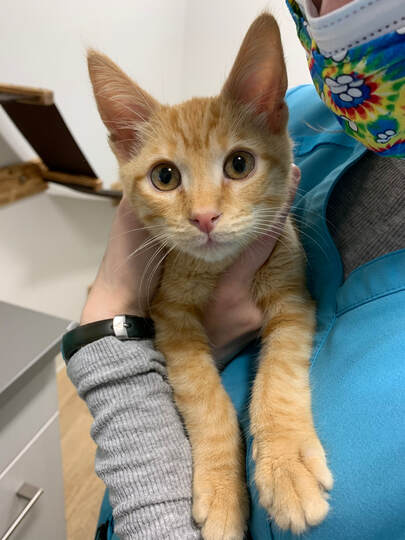 Protect your cat's beautiful smile with routine dental care! Protect your cat's beautiful smile with routine dental care! Caring for those Purr-ly Whites Let’s talk teeth! Much like humans, pets require dental care or they run the risk of plaque, tartar, gingivitis, and other periodontal diseases. Our veterinarians perform dental checkups as part of your cat’s annual visits, but you should brush your cat’s teeth at home as well! We recommend brushing daily, starting with short sessions to get your cat used to having their gums and teeth touched, before moving up to 3-5 minute sessions. For more info, check out our five-step video on cleaning your pet’s teeth. Microchipping Microchipping your pets is a safe, cost-effective way to dramatically increase the chances of finding a lost pet. A microchip is a small electronic device about the size of a grain of rice, implanted under the skin with a needle. If a lost pet is found and brought to a veterinarian or shelter they can scan for a chip, which can then be used to contact you. The microchipping process is about as painful as a normal vaccine and can be done at any routine visit, though we often implant them during sedated procedures such as neuters and spays. When to Call the Vet Over the lifetime of your cat, you’ll have moments where you wonder, Is this worth a phone call? At times like those remember the golden rule: When in doubt, always reach out. It’s what we’re here for, after all! You can call us at 978-369-3503, or email us at [email protected]. If you notice any of the following symptoms, call us or a 24-hour emergency vet immediately, as your cat may be experiencing a medical emergency:
That’s all very helpful, but…
As always, these blog posts are intended to provide general information about your pets. If you have questions not covered here or questions about your specific cat, feel free to get in touch! We’re always happy to have a quick cat chat. It's the time of year to write our New Year's resolutions. This year lets get our pets in on the act! 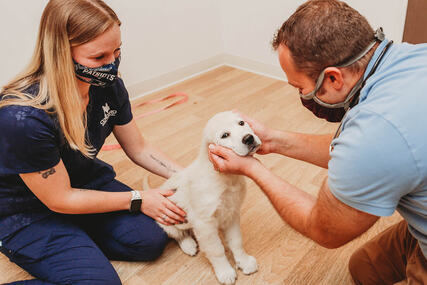 How COVID-19 is impacting pet health Pet obesity was already on the rise before the pandemic, with over half of all cats and dogs in the U.S. overweight or obese. This problem has intensified along with the pandemic according to a survey from Hill's Pet Nutrition, conducted in partnership with Kelton Global. One third of pet parents with an overweight pet say their pet became overweight since the start of the pandemic. Many of us are home all day, continually giving pets treats and exercising less. All of this comfort and indulgence can put your pet at risk for serious health issues. According to CBS News, common obesity-related conditions for dogs and cats include arthritis, bladder and urinary tract disease, diabetes, as well as excess stress on the heart and joints. How can you tell if your pet is overweight? As Dr. Wilson, a veterinarian at Concord Animal Hospital (CAH), explains, a good indicator of whether your pet might be packing some extra pounds is to take a close look at your cat or dog. “If you see their ribs, they are too skinny. If you can’t see their ribs and you can’t feel them with your hands when you rub the side of their chest, your pet may be overweight.” How can help your pet maintain a healthy weight? You can dramatically improve your pet’s quality of life and life expectancy—not to mention, avoid additional veterinary bills—when you help your cat or dog maintain a healthy weight. We can help you do this in 2021! Dr. Wilson has five tips for pet owners: Concord Animal Hospital’s 5 New Year's resolutions to keep your pet’s weight in check: 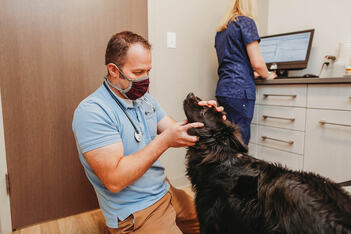
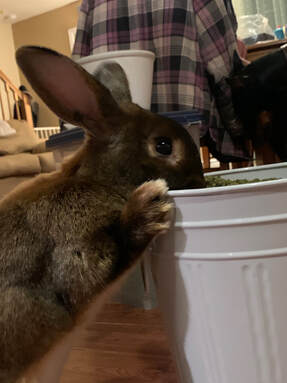
Wishing you all a very healthy and happy 2021!
According to the AVMA, a study of almost 8,000 stray pets at shelters showed that dogs with microchips were returned to their owners at twice the rate as those without microchips. The chances increase even more dramatically for cats: microchipped cats were returned to their owners almost 40% of the time compared to less than 2% of cats without microchips. When microchipped pets weren't returned to their owners, it was often due to missing or incorrect owner information in the microchip registry database – it's critical to keep your information updated for microchips to work. Does CAH recommend microchipping patients? Absolutely! A microchip is a safe and cost-effective way to dramatically increase the chances of recovering your pet. Most countries also require a microchip for jet-setting pets - check the USDA website and contact our office for questions about microchipping and other requirements for international pet travel. How is a microchip implanted? A microchip is a small electronic chip about the size of a grain of rice that is implanted under the skin with a hypodermic needle. "Despite being given with a larger needle, chip implantation is similar to giving your pet a vaccine and can be done during a routine visit to your vet," says Dr. Stephen Wilson. No anesthesia or surgery is required, though implantation can be done while your pet is under anesthesia for a spay, neuter, dental or other procedure. Is a microchip safe? Yes! Implantation is about as painful as a typical injection and adverse reactions to implanted microchips are extremely rare. A microchip can be implanted during a routine vet appointment. How does a microchip work? Microchips are activated by a scanner's radio waves - there is no battery in the microchip. A veterinarian or shelter employee will scan your pet for a microchip. If a chip is found, the chip manufacturer is contacted with the chip ID number and they will reach out to you - your information is not provided to the person who found your pet! If your contact information is missing or incorrect, your chances of getting your pet take a nose dive, so make sure to keep your information current with your microchip manufacturer! What are the limitations of a microchip? A microchip should not replace an identification tag. Typically, lost pets are found within a few hours by a good Samaritan or local dog officer and an ID tag is a quick and easy way for someone to coordinate the return of your little wanderer. A microchip doesn't replace a rabies tag, which is necessary for your pet's safety and required by Uncle Sam. A microchip is also not a tracking device - the chip is only activated when a veterinarian or other professional scans your pet. Sign up for our monthly newsletter!
New data indicates that SARS-CoV-2, the coronavirus that causes COVID-19, can infect cats, though it still doesn’t appear to infect dogs. It’s still unclear whether cats can spread the virus to people, so we urge caution but not alarm. With the first case of an animal in the US testing positive for SARS-CoV-2, the coronavirus that causes COVID-19, pet owners are understandably concerned. Two days ago a tiger in a zoo in New York City was confirmed to be infected with COVID-19. Outside of the US there have been a handful of reported SARS-CoV-2 positive pets. The American Veterinary Medical Association (AVMA) lists two dogs in Hong Kong, one cat in Hong Kong, and one cat in Belgium that have also tested positive for SARS-CoV-2.
COVID-19 in Dogs and Other Animals Data continues to indicate that dogs aren’t really susceptible to the infection. The same goes for pigs, chickens, and ducks, all included in the study published in Nature. However Ferrets are highly susceptible to COVID-19.
Keeping pets safe We urge an abundance of caution to protect pets. If you are ill with COVD-19, restrict contact with your pet and have another member of the household feed and care for your pet if possible. The US Center for Disease Control advises that if “you have a service animal or you must care for your pet, wear a facemask; don’t share food, kiss, or hug them; and wash your hands before and after any contact with them.” Don’t share bedding or any dishes, towels, drinking glasses with other people or pets in your home. While we urge caution, there isn’t any reason a pet would need to leave a home where someone is infected with COVID-19 unless no one in the home will be able to care for the pet appropriately. It’s a good idea to have a two-weeks supply of your pet’s food and medicines in case you are diagnosed with COVID-19, are quarantined or are self-isolating and can’t leave your home. Please continue to reach out with questions and concerns. We are open and here for you and your pet!
Need to pick up your heartworm or flea & tick preventatives? Stop by to pick up at CAH or try ordering from our online store! These pests are tougher than you think!
Concord Animal Hospital’s team of veterinarians gets questions about CBD and pets almost every day – here’s their take CBD and your pet.
What is CBD? CBD, or cannabidiol, is a product of both the cannabis and hemp plants. It is only legal when it is derived from hemp – any product for sale containing CBD should not be derived from cannabis. CBD does not have psychoactive properties. THC (delta-9-tetrahydrocannabinol) is the psychoactive component of cannabis, or marijuana. What research has been done on CBD and pets? Not enough! “At this point there are very few published results that determine benefits of CBD for pets or how it interacts with other medications or supplements,” notes Dr. McCullough. “Not only have benefits not been confirmed by the research, but proper dosing and CBD toxicity levels have not been defined.” There is anecdotal evidence that CBD may have benefits for pets. These claimed benefits include reducing inflammation, stimulating appetite, reducing anxiety, and controlling seizures. There are studies underway and all in the veterinary community eagerly await the results. Pet due for a visit? Book an appointment today!
What is Concord Animal Hospital’s stance on CBD? Our team of veterinarians suspects that there CBD does have health benefits for pets. However, there are significant knowledge gaps in the science, safety, and quality of CBD for pets. Until there are published studies on the safety and efficacy of CBD and standardized dosing, we do not recommend that our clients administer CBD products to their pets.
Though we don’t recommend CBD products, we want our clients to be open with us about CBD products that they are administering to their pets and to feel that they can ask us questions about CBD. We’ll discuss CBD for your pet to the best of our knowledge. We’re your partner in your pet’s healthcare and want you to feel that you can be transparent with us!
KNOW WHEN TO ASK FOR HELP - WHEN IN DOUBT JUST GIVE US A CALL! Call us at 978-369-3503 or email at [email protected] if you have any questions or concerns about your pet's health - we're always happy to help!
All of us at CAH wish you and your family, including the furry ones, a very safe and happy holiday! Thanksgiving is a time for indulgence and overeating for many of us, but don't let the excess extend to your four-legged family members. It’s for their own safety!
Want to give your pet a special treat during the holidays? Instead of sharing your meal, the Animal Rescue League of Boston recommends traditional treats that are safe for dogs and cats or something special like a food puzzle or an interactive toy like a peanut butter filled Kong. Dr. Stephen Wilson of Concord Animal Hospital notes that “in moderation, a small piece of lean turkey meat or some chopped carrots are reasonably safe treats for those doe-eyed dogs.” If you have any concerns about something your pet has eaten, call us at 978-369-3505. If our office is closed, call the Pet Poison Hotline at 855-764-7661 or ASPCA Animal Poison Control Center at 888-426-4435. A fee may apply for calling these or other poison control hotlines. We wish you and your family (including the pets!) a safe & happy Thanksgiving!
CAH’s own Dr. Stephen Wilson explains what Massachusetts dog and cat owners need to know about the risk of EEE to our pets now that this virus has arrived in our community.
What about other diseases transmitted by mosquitoes and other parasites?
Learn more about heartworm and other illness that can be transmitted to our pets by fleas, ticks and mosquitoes. Concord Animal Hospital’s tips to help keep your older cat happy & healthyA cat is considered a senior once they’re 10 years old, but don’t fear senior status! Age isn’t a disease and your senior kitty could have many more years ahead of them. We have many healthy feline patients living into their 20’s. The oldest cat on record lived to be 38! The needs of your cat change as they age but we’re here to help keep your cat happy and healthy. Follow these five tips and, as always, never be afraid to reach out with questions or concerns.
Regular veterinary care and great care at home can give your senior cat many more years with you and your family. As always, call 978-369-3503 or email us at [email protected]. No question is silly or concern too small. We’re so proud to partner with you on the healthcare of your super senior! Are Grain-Free Diets for Pets the Greatest Thing Since Sliced Bread? Not according to the fda7/1/2019
Concord Animal Hospital slices through the hype Americans are increasingly concerned with where their food comes from and achieving the right nutritional balance for a longer, happier and healthier life. And of course, that includes finding the best food for their furry family members! In an effort to improve their pets’ health, many pet moms and dads are turning to alternative diets such as grain-free pet food. And they're willing to spend big money to make sure their pet is getting the best! According to the New York Times, grain free diets accounted for nearly $2.8 billion in 2017, up from $1 billion in 2011. Owners are looking for the very best for their pets and many are replacing grains such as corn, rice and wheat traditionally found in dog food with alternatives such as chickpeas, lentils and sweet potatoes. The most at-risk population for malmourishment are growing pets, such as puppies and kittens, cautions Dr. McCullough. "It's critical to discuss your young pet's nutritional needs before trying alternative diets."
Wild dogs only live three-to-five-years due to malnutrition, parasites, and a myriad of other diseases and maladies from which we diligently protect our pets. Their lifestyle and lifespan isn’t what should aspire to for our pets!" says Dr. Rhea McCullough, CAH veterinarian. Veterinarians Urge Caution In some cases, such as pets with a grain allergy, a grain-free diet is the right choice. But according to CAH veterinarian Dr. McCullough, “for the vast majority of dogs, grains are part of a balanced diet. Far more dogs are allergic to specific proteins than to grain, so very few dogs need to be on a grain-free diet. A veterinarian should be the one to diagnose a grain sensitivity or allergy and work with you on the right nutrition plan" The veterinary community is beginning to see negative effects of grain-free diets among house pets. The U.S. Food and Drug Administration (FDA) has issues several reports warning pet owners of reports of canine dilated cardiomyopathy (DCM) in dogs eating certain pet foods containing peas, lentils and other legume seeds or potatoes as main ingredients. DCM is a disease of a dog’s heart muscle that leads to an enlarged heart and can result in congestive heart failure. DCM, which can be severe and even fatal, used to mostly impact breeds genetically prone to the disease, such as Great Danes, Newfoundlands and Irish Wolfhounds. Concerning to the veterinary community is that many recent cases reported to the FDA include breeds not typically at risk for DCM, including Golden and Labrador Retrievers, a Shih Tzu, Miniature Schnauzers, as well as mixed breeds. In many of these cases, dogs were fed diets that included potatoes or multiple legumes such as peas or lentils. It is not yet know whether the increase in these alternative ingredients is driving the new DCM cases or if it’s the absence of grain, but the FDA is looking into the cause and we have our ears pricked up. "This is heart-breaking for us, since we know pet owners are only trying to do what’s best for their pets,” says Dr. McCullough. "Many of these grain-free foods are quite expensive but a higher price doesn't guarantee higher quality. Unfortunately some companies are capitalizing are capitalizing on the grain-free trend. Pet food isn't regulated, so they're able to sell grain-free food with little to no research on benefits to or impact on your pet's health."
Your pet’s health and happiness depend on proper nutrition
An undernourished pet is at risk for serious health issues. Dr Lisa Freedman, veterinary nutritionist and a professor at Cummings School of Veterinary Medicine at Tufts University note that “in the last few years I’ve seen more cases of nutritional deficiencies due to people feeding unconventional diets, such as unbalanced home-prepared diets, raw diets, vegetarian diets, and boutique commercial pet foods.” You can dramatically improve your pet’s quality of life and life expectancy—not to mention, avoid additional veterinary bills—when you help your cat or dog achieve the right nutritional balance. So what can you do?
We love that pet owners are willing to go the extra mile for their pets. You want what’s best for your pet and so do we. We look forward to partnering with you to channel your love and dedication into foods and care that will support a happy and healthy life for your pet! With a rainy spring behind us, we’re pumped for warm weather! At Concord Animal Hospital, we know that means it’s time to prepare our clients with pet health and safety advice apropos to the coming hazy, hot, and humid season. What Is the Biggest Warm Weather Danger for Pets? As the thermometer starts to climb, the biggest danger posed by the warm weather for pets is hyperthermia, or heat stroke. Activities you might normally do at other times of year--an exuberant session at the dog park with an active pup, taking a longer walk than usual with an older or overweight pet, or leaving your four-legged friend in your car while you do a few quick errands--can put them at serious risk for heat stroke.
What Are the Risks of Heat Stroke for Your Pet? Damage from heat stroke can range from impacted eyes or GI tract, to brain damage and death. Dogs considered at higher risk for heat stroke include:
Time is of the essence and mortality rates in dogs with heat stroke are a lot lower when their owners cool them before they arrive at the hospital." How Can You Help a Pet with Heat Stroke? With the risk of heat stroke especially in dogs on the rise, Concord Animal Hospital’s Katherine Wilson sat down with Dr. Caleb Murphy, Emergency Clinician at BluePearl Specialty Hospital in Waltham to get his suggestions for first aid steps you can take to save your dog’s life. BluePearl is a 24-hour emergency veterinary hospital and one of the emergency hospitals we suggest to our patients for urgent medical assistance when our office is closed. Katherine: Can you describe what happens to a pet suffering from heat stroke? Dr. Murphy: Heat stroke, also called hyperthermia, is a failure to regulate the body’s temperature. A pet suffering from heat stroke is having an inflammatory response which leads to multi-organ dysfunction. This overheating can be a result of the pet’s own activity or metabolism or heat gained from the environment, such as on a hot day or in a warm car. Katherine: How does hyperthermia effect a dog? Dr. Murphy: Dogs lose 70% of their body heat through the skin. But when the air temperature is higher than their body temperature, dogs also lose heat through evaporation from their respiratory tract via panting. If they are suffering from hyperthermia, your dog will begin panting excessively to maximize heat loss. Internally, blood will increasingly circulate to the skin at the cost of blood flow to the internal organs, which has the potential to cause long term damage.
Katherine: What can a dog owner do if they think their dog is suffering from hyperthermia? Dr. Murphy: A lot! Time is of the essence and mortality rates in dogs with heat stroke are a lot lower when their owners cool them before they arrive at the hospital. In one study, mortality rates were 50% in dogs in the total sample, but 100% of dogs that were cooled by their owners before being admitted to the hospital and brought in to a hospital within 90 minutes of exposure survived.* If you think your dog is suffering from heat stroke, you need to get to your veterinarian immediately. Before you go, wet the dog with cold water with a hose or in a bath or sink. I advise against putting wet towels on the dog, because the towels will quickly become warm and prevent the transfer of heat away from the dog’s body. If you have ice packs, place them in your dog’s armpits and around the belly after placing your dog in the car. Turn the air conditioner on high or roll down the windows and call the vet to let them know you’re coming in while you are on the way. Stay Safe in the Heat When the sun is shining, we all want to enjoy the warm weather with our pets! By making seasonal adjustments to our activities, we can help prevent overheating and heat stroke in our pets. Doing things such as always bringing a water bottle and putting out fresh water for your pet, avoiding walks during the hottest times of day, and leaving your pet at home and not in your car when you go out to shop will go a long way to keeping your pet safe. And if your dog exhibits any of the symptoms of heat stroke noted above:
Special thanks to Dr. Murphy and BluePearl for contributing to our efforts to keep our patients happy and healthy!
*Heat Stroke in Dogs, The Hebrew University of Jerusalem, Israel. Journal of Internal Veterinary Medicine. 2006.
What Kind of Ticks Are in Our Area? There are three main types of ticks in the Concord, Massachusetts area:
How Can I Keep My Dog Safe from Tick-Borne Diseases? Our veterinarians at Concord Animal Hospital strongly recommend using tick preventatives such as Bravecto or Simparica. Some clients double-up with a chewable preventative and a repellent collar. Talk to one of our veterinarians to determine the best product for your pet given their health history, potential exposure to ticks and lifestyle. Use your preventative all year long! Please use a tick preventative year-round! Frost and freezing temps DO NOT kill ticks. Ticks are dormant but come back to life in only 40 degrees - a high often achieved even in the coldest months. Our veterinarians see plenty of dogs with tick-borne illnesses throughout the winter. Our vets also suggest taking added precautions such keeping your dogs out of long grass or and away from undergrowth. These areas are where dogs like to sniff and explore, but they are also prime hangouts for ticks. After a walk, the American Kennel Association recommends checking some spot you might forget to look, such as inside ears and between toes, just to make sure your pet didn’t bring any ticks home with them. Keep a running list of questions on ticks and any other concerns to ask during your next vet visit! What Do I Do If I Find a Tick on My Dog?
If you find a tick on your dog, remove it as soon as possible! If it hasn’t attached itself yet, there is no risk of tick-borne illness for your pet. If it has attached, grasp the tick with a pair of tweezers as close to the site of attachment as you can and pull straight back. If you have found an attached tick, particularly one that is engorged, the MSPCA advises noting the date and time to discuss with your veterinarian. Continue watching for the following symptoms*:
Concord Animal Hospital is here to help you determine if your pet needs immediate medical care It's often hard to know when your pet really needs to be seen by a vet when there isn't a clear physical injury. When in doubt, always give us a call at 978-369-3503, WE'RE HERE TO HELP!
In some situations, your pet needs immediate attention. Always call if you're concerned, but call (don't email) right away for the following situations:
Concord Animal Hospital’s 5-step guide and video to brushing your dog or cat’s teeth February is pet oral health month, so we're bringing back a video we made showing how you (yes, you!) can brush your pet's teeth! Oral health is just as important for our pets as it is for us. Pets can get plaque, tartar, gingivitis and other periodontal diseases too. According to the American Animal Hospital Association, “diseases of the oral cavity, if left untreated, are often painful and can lead to more serious health problems including heart, lung and kidney disease.” At Concord Animal Hospital, we frequently hear from pet parents that they have never brushed their pet’s teeth because they don’t know how. We’re here to help! To get started, follow five simple steps and watch our instructional video.
STEP 1: Make a plan Identify a place in the house or yard where your dog or cat will feel calm and relaxed. Pick a time of day that you can set aside 5-10 minutes on a regular basis. Dr. McCullough, a veterinarian at Concord Animal Hospital (CAH), recommends you brush your pet’s teeth every day, though every other day is the minimum to keep plaque from becoming tartar. STEP 2: Get your ducks (and dogs and cats) in a row What you’ll need:
Some pets take to tooth brushing immediately. Others, especially cats (surprise!), may need more time to ease into full tooth brushing. Work your way up to brushing over a week or two and keep all sessions short – 1-2 minutes will suffice. Dr. McCullough suggests owners get their pets comfortable by…
STEP 5: Start brushing those choppers: Gently place a toothbrush at a 45-degree angle to your pet’s teeth and brush along the gum line in a circular motion. You can either tuck the toothbrush into their mouth or gently push their lips back so the teeth are visible. You don’t have to worry about the inside of the mouth, the tongue takes good care of removing plaque from the inside-facing sides of the teeth, so focus on the outside. End the session with a reward – a favorite treat or a lot of attention. In the beginning a little bit of bleeding may occur. If the bleeding is heavy, stop and try to brush again more gently in a day or two. WHEN TO TALK TO YOUR VET If the bleeding continues after gently brushing three times, call us at 978-369-3503 to make an appointment to check your pet’s teeth as this may be a sign of dental disease. Dr. McCullough also recommends talking to your vet about the right frequency of dental cleanings for your pet and asking for help if your pet isn’t taking to tooth brushing. “Different brushing techniques or drinking water additives might be great options for you and your pet.” VET TIP: In addition to brushing teeth regularly, encouraging pets to chew rubber toys or large rawhides is also great for teeth. "The trick with any dental treat or chew toy is to get them chewing for a while," says Dr. McCullough. "If they swallow them in two bites then we're not getting the teeth clean. Toys that can be stuffed with treats are a good way to get dogs to chew for longer. Avoid hard bones, antlers and hard plastics that can fracture teeth." HAVE CONCERNS ABOUT YOUR PET’S ORAL HEALTH? Make an appointment with your veterinarian at Concord Animal Hospital at 978-369-3503. Join Our Pack!
Sign up for our email list to receive helpful information, such as our newsletter & special offers! Concord Animal Hospital's 5 Tips to Keep Your Pet Healthy This Winter
|
|
OFFICE HOURS:
Monday-Friday: 8:00 am to 6:00 pm Saturday: 8:00 am to 12:00 pm |
CONTACT INFORMATION:
Concord Animal Hospital 245 Baker Avenue Concord, MA 01742 Phone: (978) 369-3503 Fax: (978) 371-9748 [email protected] |
JOIN OUR PACK!
Sign up for our monthly newsletter, the Paw Press for hospital news, pet care tips and cute pet photos! |
Copyright © 2022


